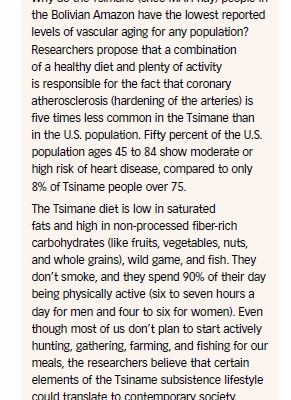1. Healthy Lifestyle Synergy
Billions of dollars are spent each year on anti-aging elixirs, wrinkle creams, hair dyes, and even cosmetic procedures to fight the effects of aging. But what if the true anti-aging formula is with you all the time, in the little choices you make every day? After all, the real goal isn’t just to look good or live longer, it’s to remain healthy and energetic enough to enjoy those extra years. While aging does put you at greater risk for health issues, disease and disability are not an inevitable part of growing older.
The most important things you can do to stay healthy, active, and feeling young as you age are to eat well and exercise. Studies show physical activity and good nutrition have benefits in reducing disease risk or managing disease and disability at any age. The World Health Organization estimates that not smoking, being physically active, and eating a healthful diet would reduce the risk of life-shortening diseases like cardiovascular disease, stroke, and type 2 diabetes by 80 percent. Members of societies, such as the Tsimane, who naturally follow these lifestyle guidelines have clear arteries throughout their lifespan (see Box 1-1, “The Right Diet and Activity Can Keep Arteries Clear for Life”).
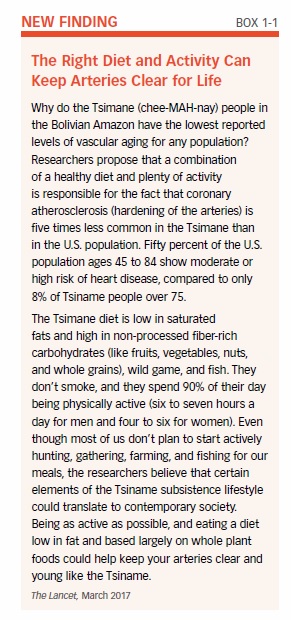
Exercise and nutrition work together to keep your body looking, feeling, and running at its best. Without adequate nutrition, you will not have the energy to be active. Without activity, you will not burn off as many of the calories you eat and you will not stay functional. But the synergy goes deeper than that, for example:
Exercise keeps your circulatory system operating at peak performance, but you need a healthy diet to keep your veins and arteries clear and flexible.
Using your muscles to lift, push, or pull encourages bone
to become stronger, but only food can supply the bone-building minerals.
Nutrients and bioactive compounds from foods slow cognitive decline; exercise increases the number of blood vessels in the brain so the nutrients can get to where you need them.
As you read on, you will find many more examples of this essential synergy between eating and exercise. No matter what your eating and activity habits are now, every change you make toward the dual goals of moving more and nourishing your body better makes a difference. This book will give you the information, tips and tricks you need to maximize your chances of leading a healthy, active life … at any age.
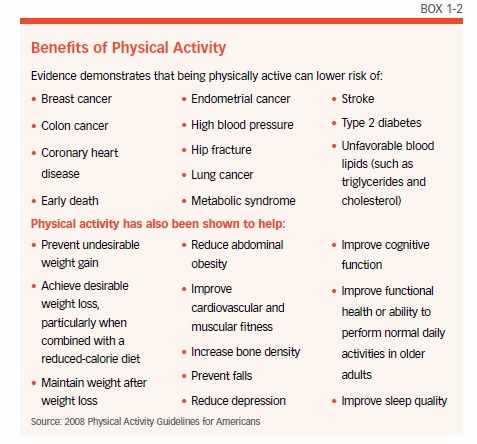
Physical Activity and the Aging Process
Being physically active is one of the most important things you can do to maintain good health and quality of life as you age.
Activity reduces risk for a number of chronic diseases, strengthens the cardiovascular system, preserves muscle function, improves mood, helps keep your brain sharp and your bones strong, and combats the physiological changes of aging on a cellular level. In fact, regular physical activity can potentially counteract the effects of 10 to 20 years of aging (see Box 1-2, “Benefits of Physical Activity” and Box 1-3, “The Impact of Exercise” on page 8).

Unfortunately, few of us get the recommended amount of physical activity (see Box 1-4, “Percentage of Adults Meeting Physical Activity Guidelines”).
Chronic Disease
Being active reduces your risk for chronic conditions, including heart disease, high blood pressure, stroke, arthritis, some cancers, type 2 diabetes, and respiratory illnesses, and there is a clear association between exercise and lower risk for all causes of death. In fact, an analysis concluded that exercise is as effective as prescription drugs in treating many common chronic health conditions, such as coronary heart disease and diabetes.
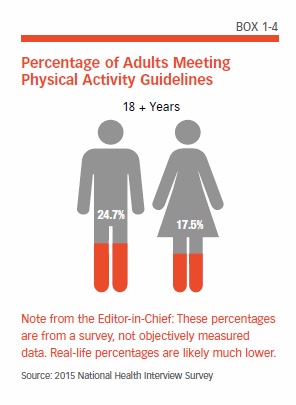
Cardiovascular disease (which increases risk of heart attack and stroke) is particularly influenced by activity. During aerobic exercise, your heart beats faster and your breathing increases to support the delivery of oxygen and nutrients to the muscles. Regular exercise makes your cardiovascular system stronger, so your heart can pump more blood with less effort, which can help lower blood pressure. Aerobic exercise also strengthens your lungs and triggers the growth of new blood vessels to help deliver oxygen to your muscles. Your body’s ability to transport and use oxygen improves, and that translates to better cardiovascular health and less fatigue. Exercise also can help fight changes in blood pressure brought about by the stiffening of blood vessels as you age.
Research shows that the higher the level of their physical fitness, the less likely a person is to die prematurely from cardiovascular disease. Based on this data, all major cardiovascular medical societies have made physical activity a key part of guidelines to prevent cardiovascular disease.
Brain Health
The number of nerve cells in the brain typically decreases with age, and the levels of the chemical substances involved in sending messages in the brain change. Although researchers aren’t sure about the exact mechanism, exercise is strongly associated with protection against age-related decline in cognitive function.
Regular physical activity also may help postpone the decline in your ability to think quickly and may help improve reaction time. Additionally, exercise may aid your ability to shift quickly between activities and plan and organize tasks. Some studies also suggest regular exercise may help reduce risk for Alzheimer’s disease. The effects of exercise on brain health are partly due to its ability to improve cardiovascular function and blood flow within the central nervous system.
Studies in animals have found that exercise increases the number of small blood vessels that supply blood and nourishment to the brain, in addition to increasing the number of connections between nerve cells. Even if you’re starting to show early signs of memory loss, exercise may still help.
One small study found that walking at a moderate intensity on a treadmill for 30-minute sessions four times a week actually increased the thickness of the outer layer of the brain. Participants with declining mental function at the start of the study showed the greatest growth in the brain regions that typically degrade quickly in Alzheimer’s disease. Studies also suggest a single session of aerobic exercise may produce short-term improvements in memory, attention, and reaction time.
You don’t have to run marathons to reap brain benefits. While there is evidence that age-related changes in brain structure and cognition can be offset by increased exercise, a recent study found that long-term endurance exercise didn’t offer much advantage over a generally non-sedentary lifestyle (see Box 1-5, “It’s Not Too Late to Protect Your Brain with Exercise”). In addition to influencing cognitive ability, physical activity also can help you relax, lift your mood, and reduce stress and anxiety. And it’s never too late to start.
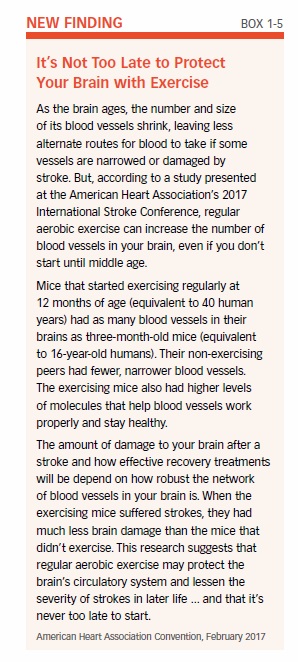
Body Composition
Body composition improves with regular exercise. Muscle, bone, and body fat all change with age. Regular exercise can help slow or reduce the changes in all three.
- Muscle: Humans begin to lose muscle mass and strength around age 30, partly due to decreasing levels of hormones that stimulate muscle growth. These “aging effects” account for about 3 to 8 percent of muscle mass loss per decade after age 30. More serious muscle loss due to aging is called sarcopenia. Losing muscle has a significant effect on strength, flexibility, walking, balance, and the ability to perform everyday tasks. Regular exercise to strengthen muscles can partially overcome or significantly delay loss of muscle mass and strength, helping you maintain independence as you get older, preserving flexibility, promoting balance, and reducing risk of falls (see Box 1-6, “Exercise Helps Retain Muscle”).
- Bone: Bones tend to become less dense with age, so they are weaker and more likely to break. Regular resistance exercise promotes stronger, denser bones. While aerobic fitness can help improve your stamina, maintain your mobility, and support your ability to perform activities of daily living, resistance exercise seems to be the best form of activity for maintaining strong bones and increasing bone mineral density.
- Fat: Percentage of body fat typically increases dramatically with age, in part due to physical inactivity. By age 75, it can be double what it was during young adulthood. Too much body fat can increase the risk of health problems, such as diabetes. In fact, excess body fat is the greatest cause of disability as people age, increasing the risk of chronic disease. A healthy diet and regular exercise can help minimize increases in body fat.
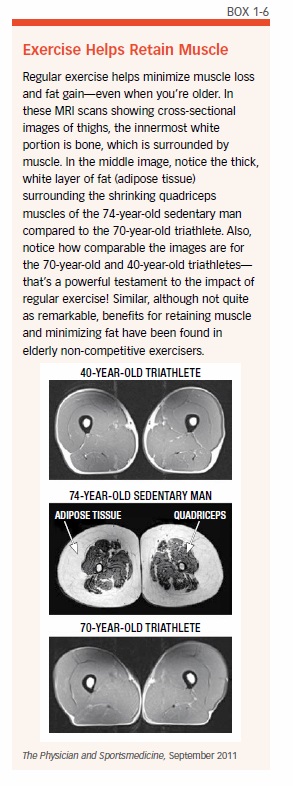
Cellular Changes
Scientists measure the age of a cell by the length of its telomeres. Telomeres are like little caps on the end of DNA strands. Every time a cell divides, the telomeres get a little more frayed and shortened. Studies have shown that shorter telomeres equate to a shorter life. Unhealthy lifestyle factors, like obesity and smoking, can speed up this process, but a recent study indicates that healthy lifestyle factors might be able to slow it down.
The study looked at telomere length and reports of physical activity in over 6,500 people. The more people exercised, the less likely they were to have shortened telomeres. This association was strongest among people aged 40 to 65, suggesting that middle age may be a key time to begin or maintain an exercise program.
It’s Never Too Late
Even if you’ve never been physically active before, research proves it’s never too late to start. One study that followed older adults over a period of eight years found that, while participants who remained physically active throughout the study were most likely to age successfully, those who took up activity during the follow-up period were also more likely to remain healthy compared with those who were inactive throughout.
Another study showed that older, sedentary men increased their muscle mass by 3.7 pounds and women increased muscle mass by 1.7 pounds with two months of strength training consisting of 30-minute sessions two or three days a week.
The Dangers of Inactivity
Inactivity ranks alongside tobacco, alcohol, and obesity as a leading cause of reduced healthy life expectancy. Beyond thinking about including formal exercise in your routine, a growing body of evidence suggests it’s also just as important to look for ways to simply sit less during the day. People spend countless hours sitting at desk jobs, watching TV, riding in cars, surfing the Internet, and so on.
Research suggests that people who sit a lot and don’t exercise regularly are likely at the greatest risk of chronic disease and premature death. However, even if you have a regular workout routine and meet the minimum physical activity guidelines, sitting too much the rest of the time can take a toll on your health, increasing risk of obesity, type 2 diabetes, cardiovascular disease, and certain cancers, among other concerns. Regardless of how much time you spend being active, a 2015 study suggests that every hour of sedentary time could dramatically increase the odds of developing problems with these everyday tasks.
Concern over the health risks of too much sitting have prompted some groups to developed specific guidelines. For example, the American College of Sports Medicine states that besides exercising regularly, there are health benefits from reducing time spent in sedentary activities and in mixing short periods of standing and physical activity with sedentary activity. Similarly, Australia’s Physical Activity and Sedentary Behavior Guidelines specifically advise minimizing the amount of time spent in prolonged sitting and breaking up long periods of sitting as often as possible.
Unfortunately, research shows that as adults age, they generally spend the majority of their day in sedentary activities. As you might guess, watching television is the most prevalent sedentary activity among older adults. Research shows that nearly 90 percent of older adults in the United States watch television on a given day, and they do this for an average of nearly five hours daily. Maybe television isn’t such a lure for you, but perhaps computer time or some other sedentary activity is. Regardless, it’s important to get up and get moving frequently throughout the day. For ideas on how to reduce sedentary time, see Box 1-7, “How to Sit Less and Move More.”

Diet and The Aging Process
Good nutrition not only fuels exercise, it also provides a potent healthy-aging impact of its own. While diet can’t reverse the aging process, it can help keep your quality of life high as you age. Research shows that adults with healthier diets have better physical function, mental health, and general quality of life in older age.
Older adults are at risk for both under-nutrition and over-nutrition. Older adults often consume too little protein for muscle strength and have low levels of vitamin B12 (important to prevent neurological deterioration) and vitamin D (essential for calcium absorption). (For a discussion of the idea that severely restricting calories increases lifespan, see Box 1-8 “Calorie Restriction.”)
“Over-nutrition” in the form of eating too much raises the risk of obesity and chronic conditions. It’s important to understand, however, that consuming more calories does not guarantee that you’re getting the correct nutrient density. Someone who overeats could experience under-nutrition.
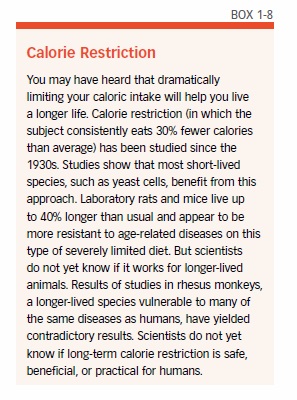
Getting the right balance gives you the nutrients you need to keep your muscles, bones, organs, and other parts of your body healthy throughout your life. A healthy diet may reduce the risk of heart disease, stroke, type 2 diabetes, bone loss, some kinds of cancer, and anemia. If you already have one or more of these chronic diseases, eating well and being physically active can help you better manage them.
Cardiovascular Disease
The best weapons against heart disease are diet and other lifestyle choices, like being physically active and not smoking. Doctors have long been aware that arteries thicken and harden as we age as a result of the buildup of plaque. They used to think that plaque built up over a lifetime like rings on a tree. Now they know that it’s irritation of the vascular endothelium (the lining of the blood vessels) that causes plaque to grow. Controlling inflammation, high cholesterol, high blood pressure, high triglycerides, and obesity can decrease risk of heart attack and stroke. What you choose to eat influences each of those factors.
Sometimes simple changes to your diet can be powerful. Presenters at the 2017 scientific sessions of the American Heart Association reported that simply eating more fruits and vegetables could significantly reduce disability and premature death from heart disease.
(For more information on eating to reduce cardiovascular disease as you age, See Box 1-9 “Nutrition Advice for Cardiovascular Health.”)
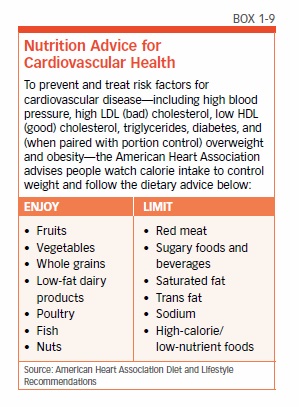
Diabetes
Not only do good food choices reduce cardiovascular disease risk, they also cut your risk of developing type 2 diabetes. The percentage of people with this life-disrupting condition increases with age. Over 16 percent of Americans 45 to 64 years old have diagnosed or undiagnosed diabetes. For 65 years or older, that percentage jumps to nearly 26 percent.
Diabetes is treated in part with diet and other lifestyle changes—the same changes that have been proven to reduce the risk of developing this disease, even in people diagnosed with pre-diabetes. Physical activity is extremely important in helping control diabetes. The more active you are, the better for improvement in insulin sensitivity. Even walking can make a significant difference.
Cancer
Research has shown that poor diet and inactivity actually increase cancer risk. In fact, one-third of the cancer deaths in the United States each year are linked to poor diet, physical inactivity, and being overweight. Diet provides nutrients and compounds that might help deactivate carcinogens, turn on tumor suppressor genes, and affect cell growth. Maintaining a healthy weight through good food choices is also an important anti-cancer strategy, since excess weight and obesity are linked to at least 13 cancers.
Body Composition
Your diet has a major impact on body composition.
- Muscle: After age 30, muscle mass begins to decline. Without physical activity, that decline continues unchecked, leading to frailty and difficulty performing everyday tasks. But evidence from large studies suggests that not only is physical activity important for maintaining muscle mass, but eating enough protein is also essential to maintaining muscle as you age. Other dietary factors, including fruit and vegetable intake, vitamin D status, and the presence of obesity, are reported to be involved in age-associated declines in muscle mass.
- Bone: Like weight-bearing exercise, good nutrition supports improved bone-mineral density, so you’re less likely to break or fracture a bone. Vitamin D, calcium, and other minerals found in healthy foods like low-fat dairy, fruits, and vegetables play an important role in maintaining healthy bones.
- Fat: Extra weight can increase the risk for diseases like type 2 diabetes, heart disease, and cancer, and can increase joint problems. While it’s essential to take in enough calories to fuel your body throughout the day, the best way to lose (or keep from gaining) body fat is to control caloric intake.
Brain Health
The right food choices can help protect your brain as you age. Epidemiologic studies have shown that the Mediterranean diet, which includes fruit, fish, vegetables, and olive oil, may actually increase brain volume and lower the risk of both mild cognitive decline and Alzheimer’s disease.
Studies suggest that a variety of nutrients are important to preserving brain health. Omega-3 fatty acids (like those found in fatty fish and walnuts), antioxidants (plant chemicals and vitamins abundant in vegetables and fruits), and certain B vitamins (B6, B12, and folate) are thought to be especially good. Don’t try to increase your intake with supplements, however, because there’s no consistent evidence that nutritional supplements play a protective role.
Vision
Age-related macular degeneration (AMD) is one of the leading causes of blindness in the United States. Good nutrition is crucial to preventing AMD. Vitamins C and E, beta-carotene, zinc, and the plant compounds lutein and zeaxanthin are important weapons in the fight against blindness. Experts also recommend you eat fish at least twice a week to support eye health.
Infectious disease
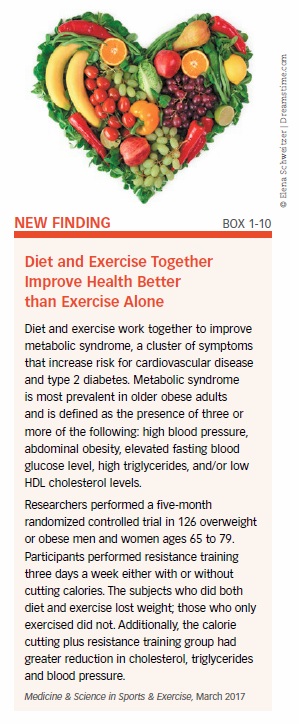
Older adults get more infectious and inflammatory diseases, take longer to recover, and are more likely to die from these diseases. These problems are largely attributed to changes in the immune system, like increased inflammation and reduced cell-mediated immune response. Fortunately, both are influenced by nutritional status.
Dietary Pattern is Key
Getting all of these benefits from your diet is dependent on achieving an overall healthful dietary pattern. A dietary pattern is the combination of different foods, drinks, and nutrients in the diet and is based on the quantities, proportions, and variety of what you eat and drink.
Older adults tend to report inadequate intakes of good food choices, like fruit, vegetables, legumes (beans, peas, lentils, and peanuts), whole grains, nuts and seeds, fish, lean meat, poultry, and low-fat fluid dairy products. They report excess intakes of foods we want to limit, including refined grain products, processed and fatty meats, fried foods, solid fats, and added sugars. The good news is that you don’t have to be perfect all the time to reap benefits from good nutrition, and a dietary pattern can (and should) be tailored to your personal tastes, preferences, schedule, and current health needs. Chapter 3 will discuss ideal dietary patterns, and Chapter 7 will give you ideas for making simple changes that make a big difference.
(See Box 1-10, “Diet and Exercise Together Improve Health Better than Exercise Alone.”)
The post 1. Healthy Lifestyle Synergy appeared first on University Health News.
Read Original Article: 1. Healthy Lifestyle Synergy »
Powered by WPeMatico

